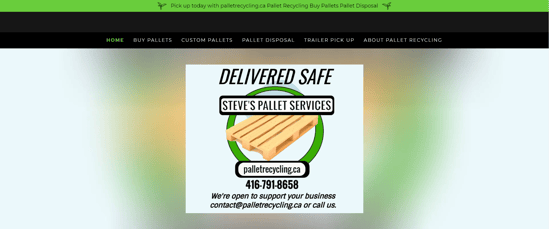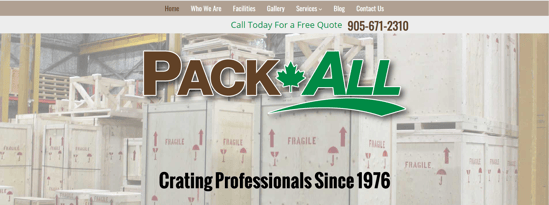To liftgate or not to liftgate, that is the question.
You’ve seen the option but may or may not have chosen it. Or – your customer may have requested it upon delivery and you only found out once you were invoiced. Let’s talk about an essential term that you must know if you’re in shipping, what is a liftgate?
Liftgate Definition
A liftgate (or tailgate) is a hydraulic lift attached to the rear of the truck that allows you to load and unload pallets with only a hand pump truck.
How Does a Liftgate work?
Liftgate’s use a hydraulic system that powers them up and down. When required, they will lower to the ground and provide you the ability to push the pallet onto the platform with a handpump which either you or the driver supplies. Once loaded, the driver lifts the gate so it’s parallel to the back of the truck, which will allow him to then load the skid inside the trailer.
Liftgates are frequently used in offloading shipments in residential areas. Sometimes customers forget to mention they’ll be needing a liftgate and shippers are charged extra for redelivery ($ 100-500). This is called an accessorial charge, A liftgate charge usually averages around $ 50- 100.
When Do I Need a Lift Gate?
There can be a few situations where you may need a liftgate, here’s a list:
- No Loading Dock: If you’re a new business owner and have a large item being shipped to you, chances are you don’t have a loading dock. If your individual freight items weigh more than 150 pounds each a forklift or liftgate is typically required.
- Construction Sites: Are you a business expanding your operations ? You will in most cases need a liftgate as you won’t have an already existing shipping dock built.
- Residential/ Home Delivery: At Freightcom we have substantial experience dealing with the residential lift gate request. In a number of cases our clients choose to use a liftgate so that their customers don’t go through the trouble of lifting their large shipments by themselves. Using the liftgate option during residential deliveries is essential when sending out large shipments.
Now that we understand what a liftgate is and when you need one, let’s talk about the benefits of using a liftgate vs lifting your shipment the old fashioned way.
What Are the Benefits of Using a Liftgate ?
- Prevents Injuries
Lifting heavy shipments may cause injuries. It doesn’t matter if you’re shipping to a business or residential address, it makes business sense to provide a liftgate service to your customer.
If your customers are lifting the shipment manually this can not only waste time for them, but in the case of an accident could also get you in legal trouble. To mitigate your risk, we recommended using a liftgate for all heavy shipment deliveries.
- Prevents Damage
If you’re a business or consumer shipping valuables to your address, it’s possible that the trailer may be too high for you to effectively carry the shipment. This may cause you to damage the shipment as you are unloading it. We recommend using a liftgate especially in the cases of valuable freight.
- Requires Less Personnel
Do you remember the last time you moved something heavy ? It’s safe to assume you didn’t do that alone. When offloading heavy freight, you may require a number of employees to complete the task effectively. Your unloading crew will use up more time as they manually try to offload your freight. For best efficiency, safety and ease, use a liftgate.
Are There Limitations to the Liftgate?
Absolutely. You’ll need to understand that liftgates are designed to work with your typical standard size pallets. The gate has a maximum width as well as height and weight limitation. Let me explain;
- Depending on the style of truck picking up or dropping off, it may come equipped with roller doors or barn doors. Where barn doors swing open and roller will turn inside the truck. If it’s a roller-style, it’s going to limit the height of the skid fitting inside through the door. While the height maximum doesn’t necessarily mean much with a liftgate, it’s still important to know as a roller door may be a more common truck dispatched.
- It’s typical for the liftgate not to be equal to the maximum width of the trailer. It probably won’t be too important as many skids won’t exceed 50” but it’s still important to consider.
- Being mindful of the skid length is very important. If your skid is longer than the platform for the gate, you’ll end up with the skid’s back end lifting in the air once the gate is lowered. Common sense will probably let you know that it’s not going to work without potential for damage if the driver even allows it to happen
- The weight of your pallet(s) is something you must also be mindful of. While some lifts may allow 3500lbs, the most you may be looking at is 2000lbs to be safe.
Are you looking to buy skids, pallets, or crates to use for your shipments? Here’s a few of our recommended sellers:
4. New Pall
So there you have it. If ever in doubt between who will dispatch what truck or what the maximum length or weight might be, especially when utilizing Freightcom’s system when we offer such a wide variety of options, reaching out to our experts to get the answer before shipping is extremely important. Nobody expects you to memorize each carrier’s limits, and that’s why we have a team that handles these things exclusively.
No account with Freightcom? What are you waiting for? Sign up today free, and browse our selection of carriers and service offerings.




.png?width=250&height=58&name=MicrosoftTeams-image%20(28).png)